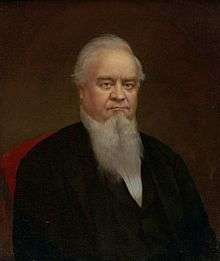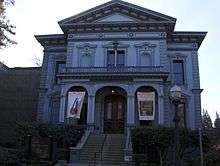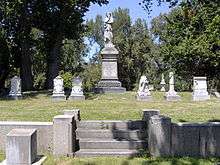Edwin B. Crocker
Edwin Bryant Crocker (26 April 1818 – 24 June 1875) was a California Supreme Court Justice and founder of the Crocker Art Museum in Sacramento, California.
Edwin B. Crocker | |
|---|---|
 Edwin B. Crocker, c. 1872 by Stephen W. Shaw | |
| Associate Justice of the California Supreme Court | |
| In office May 21, 1863 – January 2, 1864 | |
| Appointed by | Governor Leland Stanford |
| Preceded by | Stephen Johnson Field |
| Succeeded by | Elections under 1862 amendment to California constitution and 1863 enabling law |
| Personal details | |
| Born | Edwin Bryant Crocker April 26, 1818 Jamesville, New York, USA |
| Died | June 24, 1875 (aged 57) Sacramento, California, USA |
| Spouse(s) | Mary Norton
( m. 1845; death 1847)Margaret Rhodes ( m. 1852) |
| Children | Aimée Crocker Jennie Louise Crocker Fassett |
| Occupation | Lawyer California Supreme Court Justice |
| Known for | Crocker Art Museum |
Biography
Crocker was born in Jamesville, New York to Isaac and Elizabeth Crocker. He earned a degree in civil engineering at Rensselaer Institute in Troy, New York. He went on to read law in South Bend, Indiana.[1] While there, he started a practice that earned him a reputation as an abolitionist.[2][3] In April 1849, he visited California.[4] In June 1850, Crocker lost a civil case brought by a slave owner for helping four slaves escaping from Kentucky.[5] In July 1850, Crocker attended the Liberty Party convention in Syracuse, New York, where he retold the story of helping the slaves.[6] In June 1851, he spoke at the Christian Anti-Slavery State convention in Indianapolis, Indiana.[7][8] In August 1852, he was named a delegate from Indiana to the Free Soil Party convention.[9] In 1852, he and his second wife moved to Sacramento, California.
When they arrived in Sacramento, Crocker resumed his legal career. He was also involved in politics. On March 8, 1856, he chaired the state's first meeting of the Republican Party.[10][11] In 1863, Governor Leland Stanford appointed Crocker as an Associate Justice of the California Supreme Court, which position he held from May 21, 1863, to January 2, 1864.[12] In 1863, elections were held for all seats on the Supreme Court due to an 1862 amendment to California constitution and 1863 enabling law, and Crocker chose to step down rather than seek re-election.[12]
The next year, Crocker agreed to serve as legal counsel for the Central Pacific Railroad, a company run by the Big Four, which included Edwin's younger brother, Charles Crocker.[13] Crocker served as the Central Pacific's attorney during the building of the First Transcontinental Railroad, culminating in the ceremony for the driving of the golden spike at Promontory, Utah, on May 10, 1869.

The stress of all of his work took a toll on Crocker. He suffered from a stroke in June 1869. He retired from his other pursuits and took up less stressful hobbies. With a net worth of a million dollars from railroad investments, Crocker and his family traveled throughout Europe and collected art.[14] His family renovated their home to include an art gallery. Their home and the art that they had acquired would eventually become the Crocker Art Museum.[15]

After his stroke, Crocker's health never fully recovered. On June 24, 1875, he died in Sacramento.[16][17] He is interred in the Sacramento Historic City Cemetery in Sacramento, California.[18]
Personal life
On September 3, 1845, Crocker married Mary Norton in Mishawaka, Indiana. She died on April 12, 1847, in South Bend, Indiana. They had a daughter, also named Mary. On July 8, 1852, he remarried to Margaret Rhodes in New York in a ceremony performed by Henry Ward Beecher.[15][12] They had four daughters: Aimée Crocker, Jennie Louise Crocker Fassett, Nellie Margaret and Kate Eugenie Gunn, and two sons Edwin Clark, who died as a baby, and Elwood Bender, a relative who they adopted.
References
- "Commissioners and Sheriff's Sale". The Plymouth Pilot (Plymouth, IN). September 17, 1851. p. 3. Retrieved September 12, 2017.
- "Liberty Paper at Washington City". The Daily Union (Wash, D.C.). Library of Congress Historic Newspapers. November 2, 1846. Retrieved September 12, 2017.
- "E. B. Crocker (advertisement)". The National Era (Wash, D.C.). Library of Congress Historic Newspapers. June 20, 1850. p. 100. Retrieved September 12, 2017.
- "Movements for California". The New York Herald. Library of Congress Historic Newspapers. April 1, 1849. p. 4. Retrieved September 12, 2017.
- "Important Decision". Indiana State Sentinel. Library of Congress Historic Newspapers. June 20, 1850. p. 1. Retrieved September 12, 2017.
- "Liberty Party Convention at Syracuse". New-York Daily Tribune. Library of Congress Historic Newspapers. July 9, 1850. p. 1. Retrieved September 12, 2017.
- "The Christian Anti-Slavery Convention". Indiana State Sentinel. Library of Congress Historic Newspaper. June 5, 1851. p. 1. Retrieved September 12, 2017.
- "Anti-Slavery Christian Convention". The National Era (Wash, D.C.). Library of Congress Historic Newspapers. July 10, 1851. p. 112. Retrieved September 12, 2017.
- "Delegates to the National Free Soil Convention". The New York Herald. Library of Congress Historic Newspapers. August 7, 1852. p. 2. Retrieved September 12, 2017.
- "First Republican Club". Sacramento Daily Union (92 (24)). California Digital Newspaper Collection. 14 September 1896. p. 6. Retrieved September 12, 2017.
- "A History of Long Ago, First Republican Club in This State Was Organized in Sacramento Fifty Years Ago Yesterday—Three Survivors". Sacramento Union (16). California Digital Newspaper Collection. 9 March 1906. p. 1. Retrieved September 12, 2017.
- Johnson, J. Edward (1963). History of the California Supreme Court: The Justices 1850-1900, vol 1 (PDF). San Francisco, CA: Bender Moss Co. pp. 86–88. Archived from the original (PDF) on December 27, 2016. Retrieved August 14, 2017.
- "To the Pacific Coast". Evening Star (Wash, D.C.). Library of Congress Historic Newspapers. October 12, 1909. p. 17. Retrieved September 12, 2017.
- "San Francisco. It's Men". Chicago Tribune. Library of Congress Historic Newspapers. June 22, 1871. p. 2. Retrieved September 12, 2017.
Charles Crocker, a large, stout florid man, is Vice President of the Central Pacific and worth $6,000,000. E. B. Crocker, ex-State Justice, brother to the above, is worth $1,000,000.
- "Judge Edwin B. Crocker (1818-1875)". Crocker Art Museum. 2010. Archived from the original on November 21, 2010. Retrieved March 17, 2011.
- "Latest Telegrams". Carson Daily Appeal (Carson, NV). Library of Congress Historic Newspapers. June 25, 1875. p. 3. Retrieved September 12, 2017.
- "Judge Crocker Dead". Los Angeles Daily Herald. Library of Congress Historic Newspapers. June 26, 1875. p. 2. Retrieved September 12, 2017.
- "Self Guided Tour" (PDF). Old City Cemetery Committee, Inc. January 2006. Archived from the original (PDF) on 2017-12-09. Retrieved January 29, 2011.
External links
| Wikimedia Commons has media related to Edwin B. Crocker. |
- Edwin B. Crocker at Find a Grave
- Past & Present Justices. California State Courts. Retrieved July 19, 2017.
- Portrait of Edwin B. Crocker. Calisphere.org.
| Legal offices | ||
|---|---|---|
| Preceded by Stephen Johnson Field |
Associate Justice of the California Supreme Court 1863–1864 |
Succeeded by Elections under 1862 amendment to California constitution and 1863 enabling law |